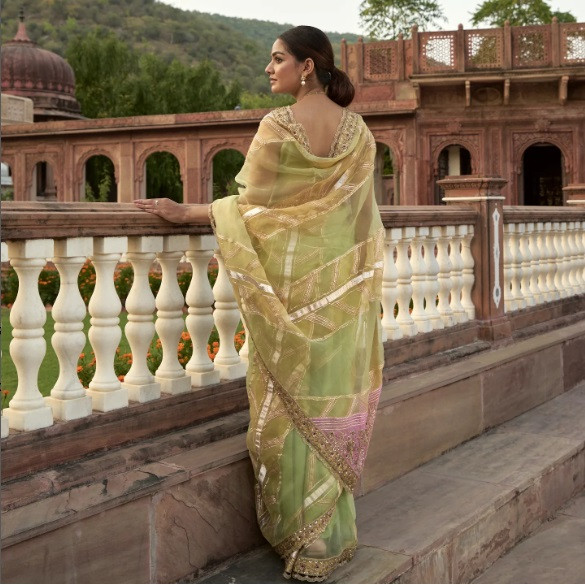In the realm of Indian ethnic wear, few garments carry the cultural heritage and artistic finesse as gracefully as the leheriya saree. Originating from the colorful land of Rajasthan, these mesmerizing creations are a testament to India's rich textile tradition and craftsmanship. From their distinctive wave-like patterns to the vibrant hues that adorn them, leheriya sarees stand as an embodiment of timeless elegance and unmatched beauty. Let us delve into the captivating world of leheriya sarees, exploring their history, craftsmanship, and enduring appeal.
History and Origins:
The history of leheriya sarees traces back centuries, finding its roots in the desert state of Rajasthan, India. The word "leheriya" itself is derived from the Hindi term "leher," meaning wave, which aptly describes the characteristic rippled patterns adorning these sarees. Historically, leheriya sarees were associated with the tie-dye technique, where skilled artisans would meticulously tie sections of the fabric before dyeing to create the distinctive wave-like patterns.
Traditionally, leheriya sarees were worn during special occasions and festivals, particularly by women in Rajasthan and Gujarat. These sarees were not only a symbol of tradition but also a reflection of the vibrant cultural tapestry of the region. Over time, the popularity of leheriya sarees transcended regional boundaries, captivating fashion enthusiasts worldwide with their unparalleled charm.
Craftsmanship and Techniques:
What sets leheriya sarees apart is the intricate craftsmanship and the labor-intensive techniques involved in their creation. The process begins with selecting the finest quality fabrics, such as chiffon, georgette, or silk, which serve as the canvas for the artisans' creativity. Each saree undergoes a series of steps, starting with the tying of intricate patterns using threads or resist material.
Once the patterns are meticulously tied, the saree is dipped into vats of vibrant natural or synthetic dyes, allowing the colors to seep into the untied sections while the tied portions remain unaffected. This process is repeated multiple times to achieve the desired depth and complexity of hues, resulting in the characteristic undulating patterns that define leheriya sarees.
After dyeing, the saree is carefully washed to remove excess dye and then left to dry in the sun, allowing the colors to set and the fabric to regain its natural sheen. Finally, skilled artisans add embellishments such as zari work, sequins, or mirror work to enhance the saree's beauty and give it a touch of opulence.
Variety and Designs:
One of the most enchanting aspects of leheriya sarees is the sheer variety of designs and color combinations available. From subtle pastels to bold and vibrant hues, leheriya sarees come in a spectrum of colors that cater to every taste and occasion. Traditional motifs such as peacocks, flowers, and geometric patterns are often incorporated into the designs, adding to the saree's allure.
While the classic wave-like patterns remain timeless, contemporary designers have infused modern elements into leheriya sarees, experimenting with different textures, fabrics, and embellishments to create unique and avant-garde designs. Whether it's a traditional wedding or a chic cocktail party, there's a leheriya saree to suit every style and setting.
Cultural Significance:
Beyond their aesthetic appeal, leheriya sarees hold profound cultural significance in Indian society. In Rajasthan, these sarees are an integral part of the state's cultural heritage, worn during festive occasions such as Teej, Gangaur, and Holi. They also hold ceremonial importance, with brides often adorning themselves in exquisite leheriya sarees for their wedding day, symbolizing purity, grace, and auspiciousness.
Moreover, leheriya sarees serve as a symbol of women's empowerment and artistic expression. The intricate craftsmanship involved in their creation provides livelihoods to countless artisans, particularly women, who have honed their skills over generations. By preserving and promoting the legacy of leheriya sarees, these artisans not only contribute to the socio-economic fabric of their communities but also keep alive a cherished tradition for future generations to admire and cherish.
Fashion and Global Appeal:
In recent years, leheriya sarees have transcended traditional boundaries to become a global fashion phenomenon. Fashion designers and enthusiasts worldwide have been captivated by the timeless charm and versatility of these sarees, incorporating them into contemporary ensembles and runway collections. From Bollywood celebrities to fashion influencers, everyone is embracing the elegance of leheriya sarees, redefining them as a symbol of modern sophistication and cultural pride.
Whether it's a red carpet event or a casual outing, a well-draped leheriya saree never fails to make a statement, exuding grace, poise, and understated glamour. Its ability to seamlessly blend tradition with modernity makes it a wardrobe essential for women of all ages and backgrounds, transcending fleeting trends to become a timeless classic.
Conclusion:
In a world where fashion trends come and go, leheriya sarees stand as a timeless testament to India's rich textile heritage and artistic prowess. From their humble origins in the heart of Rajasthan to their global acclaim on fashion runways, these sarees have journeyed through time, enchanting generations with their unparalleled beauty and grace. As we celebrate the enduring legacy of leheriya sarees, let us continue to cherish and preserve this cultural treasure, ensuring that its ripple effect continues to inspire and captivate for generations to come.
For more info:- rajput poshak
















